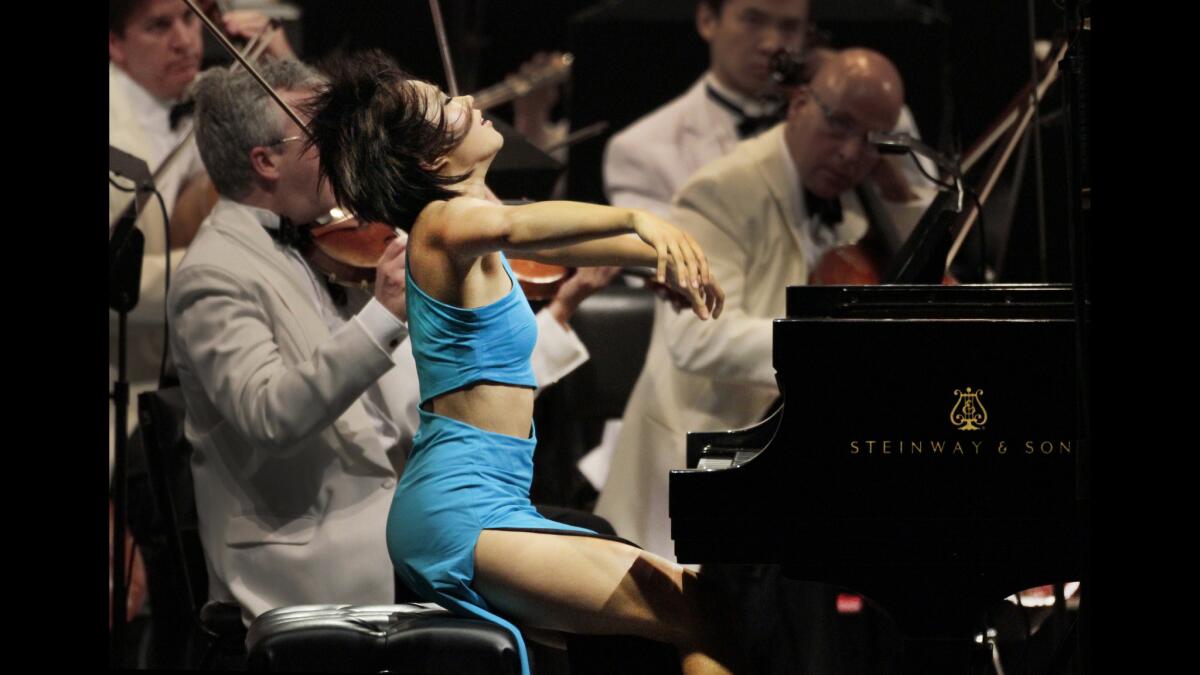Salonen leads Yuja Wang, L.A. Phil through Russian turmoil

- Share via
There have been changes at the Hollywood Bowl since Esa-Pekka Salonen’s last appearance at the amphitheater six years ago as the Los Angeles Philharmonic music director.
That meant Thursday night the now L.A. Phil conductor laureate met for the first time the flashy high-definition video screens, sound system and new furnishings, to say nothing of the flashy Yuja Wang. The Chinese pianist has become a Bowl sensation ever since her debut in the amphitheater three years ago in a small orange dress.
Taking into account Wang’s penchant for Russian piano music, Salonen put together a clever and illuminating echt-Esa-Pekka program of the first two symphonies and piano concertos by Prokofiev and Shostakovich.
As expected, Wang dressed for the occasion. A tiny, tight sparkling black number suited Shostakovich. A slinky long teal gown, with partially bare midriff and a slit up the side that reached the legal limit was for Prokofiev. The video cameras, though, were more cautious about how much they revealed than in the past, treating the pianist respectfully. She returned the favor to the composers.
What Salonen’s program revealed, though, was the way the two most important 20th century Russian composers got their starts contending with confusing artistic and political times. Both composers began as early 20th century radicals, full of wild spunk, who too quickly had to face political realities.
Prokofiev’s Piano Concerto No. 1 — written in 1911, when Russia was in revolutionary fervor — is the work of a 19-year-old with unbounded spirit and of a fearless pianist ready to change the world. Six years later, with Russia in turmoil at the time of the October Revolution, Prokofiev pulled back from radicalism and wrote what appeared to be a comfortably reactionary “Classical” Symphony in the style of Haydn.
Though 15 years Prokofiev’s junior and reacting to different political and artistic issues, Shostakovich followed a similar trajectory. His first symphony, a 1925 student work by a 20-year-old, picks up on the Russian Constructivist impulses of the early 20s. By the time of his First Piano Concerto seven years later, he was still pushing boundaries, but also needed to watch his step. Stalin was in power, and the Soviet imperative was no longer boldly experimental but nervously populist.
Salonen began the program with Prokofiev’s symphony. The piece is, on the surface, an easygoing delight and no threat to Bowl picnics. An old Haydn hand, Salonen relishes Haydn’s symphonic wit. But it was an exceedingly dry different wit that he brought to Prokofiev.
His attention here was on everything that wasn’t “Classical,” on the rhythms that don’t always conform, the startling jumps in register that are a Prokofiev trait, the citric acid squirted into otherwise conventional harmony. The “Classical” Symphony suddenly turned sly, sounding under Salonen like a buoyant distortion of the Classical style as apt musical representation for a revolutionary Russia in which there was no turning back. Shostakovich’s concerto, which followed, is for piano, trumpet and strings. This was Wang’s first time performing it, and she used a score, turning pages in virtuosic flurry. She was, though, uncharacteristically cautious.
Shostakovich begins with a jazzy, almost nose-thumbing nerve, turns wildly sarcastic in the second movement and then gets deep, solemn, agitated, angry and finally furious in the later movements. He was a neurotic composer, and you can feel the tension, the turnaround from simple experimental thrills.
Salonen made a feisty recording of the concerto with Yefim Bronfman and the L.A. Phil in 1999. Here he went for a more considered approach, possibly in consideration of Wang. Her trademark confidence and zeal were apparent. She brought a fine lyric reserve to the slow movement and loved getting into an exciting rhythmic groove at the end, which is the kind of music in which she excels.
She stole the show, of course. This kept L.A. Phil principal trumpet Thomas Hooten a little too much in the back seat. But he is a naturally reserved player, and he did contribute a fine melancholy to the slow movement.
For Prokofiev’s concerto, Wang was fully in her element. No longer quite so deferential to Salonen, she took off like a rocket, all glitter and rhythmic sass. The slow movement is a marvel, revealing already at 19 that Prokofiev was capable of the bittersweet strangeness that would mark his greatest music. This, too, Wang takes to with expressive ease. It was an impressive performance.
So, too, was the Shostakovich First Symphony, which closed the program. Just as Prokofiev had been himself at that age, Shostakovich was already Shostakovich by the time he reached 20. That, however, meant he was looking over his shoulder a lot more than the older composer and was a much bigger mess of a symphonist.
The First is all over the place, and Salonen allowed it its manic-depressive swings between exuberance and severity but without insisting on order when there isn’t any. But he let nothing get out of hand.
The orchestra was in top form. This is a symphony of solos, at times almost a concerto for the L.A. Phil’s outstanding pianist, Joanne Pearce Martin. There were also terrific moments from concertmaster Martin Chalifour, cellist Robert deMaine, timpanist Joseph Pereira (this kitchen-sink symphony is a timpani concerto, too, at one point) and clarinetist Burt Hara.
More to Read
The biggest entertainment stories
Get our big stories about Hollywood, film, television, music, arts, culture and more right in your inbox as soon as they publish.
You may occasionally receive promotional content from the Los Angeles Times.











